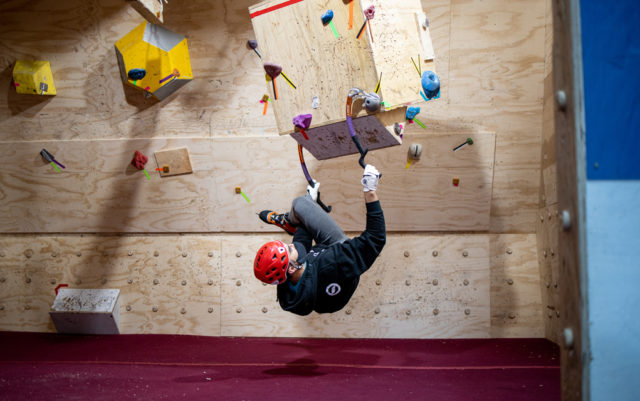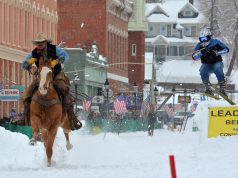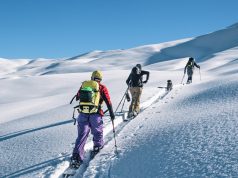
When Tyler Kempney and Wes Fowler set out for Longs Peak in October 2018, they weren’t sure what they might find. But the pair of ice climbers were prepared for anything.
The year before, Kempney had attempted a first ascent of a particularly elusive ice smear on the lower east face of the tallest peak in Rocky Mountain National Park, an area known as The Longs Cirque, with the infamous Diamond lurking overhead. But that day, the sun was strong and Kempney was skeptical of the integrity of the ice. On that first attempt, Kempney and his partner bailed on the climb after noticing water running behind the thin sheet of ice, making it unstable. Within two minutes of getting back to the ground and moving out of the way, Kempney says, the entire smear shattered to the ground.
“Hundreds and hundreds of pounds of ice just fell where we were standing,” he says. “So we would have been crushed.”
The following year, Kempney and Fowler trudged through eight hours of snow, a hike that usually takes 2.5 hours, to find the ice smear in near perfect condition. Although the ice was only centimeters thick in some place, Kempney led the route, Fowler following behind.
The pair called it Conditional Love, and it was the first new route added to the wall since 2000.
Given the arid conditions, Conditional Love didn’t appear in 2019. Same with this year. The ice on Longs is best in October and gone by November, when there’s just enough moisture to form before it gets so cold that there’s nothing left to freeze, making training for such an objective difficult. “It’s this weird thing, where the hardest ice you might climb this year is in first,” Kempney says. “So there’s no real warm up.”
That is until the 2,000 square-foot Ice Coop in Boulder opened in August 2019. Envisioned by Rock and Resole co-owner Sally Gilman, the bouldering cave housed in an East Boulder warehouse was created specifically for dry tooling — the art of using ice axes and crampons on rocks, or in this case climbing holds. Gilman began formulating the idea in Ouray a few years prior, laid up in bed with a stomach bug while her husband and friends were out climbing ice.
“My big impetus for this came when I was looking for a place to warm up for ice season and get ready and there just really weren’t very many,” she says. An ice climber for more than a decade, and a rock climber for much longer than that, Gilman knew there was a latent community of ice climbers who could benefit from a training facility — climbers like Kempney.

As a kid, Kempney says he loved climbing trees until one day he went into a sports shop with his dad.
“And I saw a video of people ice climbing, and I saw all the gear. And I was like, that would make climbing trees a lot easier,” he says.
While at college in upstate New York, he began rock climbing in the school’s gym, learning all the facets of the sport as he got his degree in outdoor recreation. With plans to get married later that year and with a now-or-never attitude, Kempney took graduation as the impetus to start saving money (by eating peanut butter and jelly every day or relying on the generosity of friends who purchased him meals) to buy his own ice climbing equipment.
“You could dabble in rock climbing, get a pair of shoes from a friend, find a pair of shoes for like 50 bucks, borrow a friend’s harness and helmet,” he says. “But with ice climbing, if you don’t own your own boots, then you can’t really do anything.” The entry-level price point is above the several-hundred-dollar mark, plus you need a bevy of tools and crampons as well.
A month before his wedding, he climbed ice for the first time and hasn’t looked back since.
Since moving to Boulder, he’s been enmeshed in the local ice climbing scene, meeting Gilman through industry connections and becoming the Ice Coop’s manager. Drawing on his experience managing a climbing gym in New York, mixed with his ice experience, Gilman tasked him with building out the Ice Coop space with freestanding 15-foot wooden climbing structure with its own support beams.
Connected to ice climbers across the country from the Pacific Northwest to New England and everywhere in between, Kempney designed the Boulder space by talking to friends about what they’d want in a gym, as well as checking out others home gyms.
“I could say that I designed this whole thing myself, but it’s really a collaboration of all the communities that really helped put this thing together,” he says.
Gilman and Kempney attest the Ice Coop is the first of its kind in North America. There may be something similar in South Korea or Russia or maybe even Australia, but not in the U.S. or Canada. Other climbing gyms may allow dry-tooling practice, utilizing specialized tools made of a wooden handle and leather loop that climbers use to loop over traditional climbing holds. But at the Ice Coop, climbers use their axes to hook onto specialized holds, with the occasional swing into the plywood itself. They can also kick their front points into the walls, simulating the force needed to kick into ice to secure a foothold.
The holds at the Ice Coop are manufactured in the Midwest as well as World Cup variations from South Korea and Russia. There are even some from Switzerland, made of granite covered in resin. The holds have dimples for tools, not so comfortable to grasp with your hands, some even unclimbable without tools, like a metal ball drilled onto the wall, perfect for hooking with an axe, but impossible to use in traditional climbing. For the one-year anniversary, Kempney made the “birthday box,” a swinging wooden structure in the middle of the gym covered in these holds.
Gilman says she heard skepticism from some climbers, those that came into Rock and Resole for example, unsure that there was enough demand for the Coop. But that only fueled Gilman’s idea more, adding to it the goal of building a robust ice climbing community along with the training facility.
“I wanted to kind of dispel that little idea that ice climbing wasn’t really a legitimate sport for some reason,” she says.
About a dozen or so World Cup ice climbers train at the Boulder facility, Kempney says, including himself. Ice climbing is a growing sport in the U.S. as the country introduced its first sanctioned team in 2018, put together to compete internationally. Americans competed for several years before then, but without the backing of a federation, a role the American Alpine Club now serves. It really all came together around the February 2019 World Cup event held in Denver. With a variety of events, organizers erected a tall ice wall as well as a plywood route with overhanging boxes in the middle of Civic Center Park, drawing 25,000 spectators over two days.

But the Ice Coop isn’t just for competitive athletes, Gilman says. She created it “to give people a warm, safe environment where they can go in and hold a tool and try to pull on it, see what that feels like and to maybe put on a boot on with a crampon and kick into the plywood and get a little feel for what it’s like to kick into ice.”
Mentorship is also a focus for the folks at the Ice Coop. Dry tooling in the gym is one thing, but getting out on the ice, reading the conditions and making wise choices is almost impossible without the training of a good mentor, Gliman and Kempney attest.
“It’s very hard to get into ice climbing. You have to know somebody,” Gilman says. “Fortunately, I started with a fellow that was really knowledgeable and could really teach me a lot, but not everybody, you know, knows a friend or has a buddy that ice climbs.”
Reading ice is akin to reading snow conditions while backcountry skiing — it takes training, precision and going with those more practiced than yourself, Kempney says.
“It takes a really good mentor to teach and for you to understand where the ice is better than other places,” Kempney says. “Reading a route from the ground is very difficult for people that didn’t have a solid mentor.”
It starts with identifying the surrounding geology and geography that’s creating an ice smear. The cliff could be rooting trees and other plants in a solid layer of soil which retains water content that slowly drip down the rock. Or the ice could be the result of a large snow bowl above the climb, that could present avalanche danger, or it could have formed from spray off a nearby waterfall. But climbers also have to read the ice itself, understanding how the main water source freezes, looking for hints of blue to determine water content, whether aeration is happening (causing quick evaporation and weak ice) and how the ice freezes on top of itself in layers, Kempney says.
“With ice climbing, it’s a game of patience,” he says.
And determination. With its arid environment, Colorado doesn’t generate much ice compared to other places like Wyoming and Montana in the West, or wetter and colder environments like the Northeast or Michigan’s Upper Peninsula. And the areas that do get good ice require hours of hiking, maybe even a winter overnight. The ones that are more accessible can be fairly crowded when conditions are right. Perhaps the most popular spot in the state is Ouray’s Ice Park, where the ice is farmed via cannons at the top of walls purposefully dripping to form climbs. Other routes form naturally nearby, as well.
As for his own career, Kempney is preparing for the decades-old Ouray Ice Festival (going virtual this year) with the goal of podiuming and even winning a World Cup someday. When he’s not focused on competition, though, he’s putting everything he has into building the community at the Coop, where he not only manages but also coaches and trains beginners and competitors alike.
Unlike other area gyms, there isn’t a pecking order, Kempney says, but rather a spirit of encouragement and camaraderie. Calling the sport, “goofy, low-key and niche,” Kempney says the gym has helped “build and shine light into a corner of a community that doesn’t really get much attention.”
And with 30 members, interest in the community is continuing to grow. Before the first of the coronavirus shutdowns hit Colorado, Gilman and the Coop hosted a ladies’ climb night in February with about 25 women milling about, chatting, watching and encouraging each other attempting routes. The plan was (and hopefully will be again) to host such nights every month.
Despite an exciting start, Gilman says pandemic restrictions and safety precautions have threatened the gym’s viability. It currently isn’t open on weekends and only a few climbers are allowed in the space at a time to adhere to social distancing guidelines. But she’s committed to hanging on over the winter, hoping the spring brings with it a vaccine that will allow places to open up again. And with that, she expects more and more places like the Ice Coop will start popping up soon.
“This is the first indoor dry-tooling gym around in North America,” she says, “but it’s not the last.”














